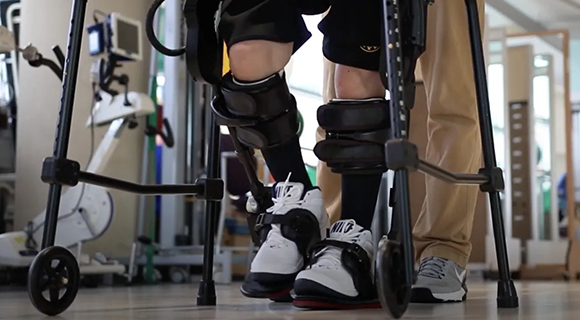A ‘Milder’ Therapy for Lumbar Spinal Stenosis
Minimally invasive lumbar decompression, also known as MILD, may offer relief to patients with lumbar spinal stenosis without the potential consequences of open laminectomy.

This MRI shows an axial section of a lumbar vertebra demonstrating moderate central canal stenosis with ligamentum flavum hypertrophy. Provided that clinical symptoms are present, the patient would be an optimal candidate for minimally invasive lumbar decompression.
Millions of older adults worldwide suffer from lumbar spinal stenosis with neurogenic claudication, in which narrowing of the spine impinges on nerves to cause both lower back pain and intermittent leg pain. First-line treatments typically progress from physical therapy to pain medications to lumbar epidural steroid injections, but these relatively conservative measures don’t attack symptoms at their source. Open laminectomy with decompression is the definitive therapy for this condition, easing the pressure that causes both back and leg pain. However, it’s also a major operation with risks that disqualify many potential candidates, and a recovery that lasts for weeks or months, says Johns Hopkins rehabilitation physician Gerard Limerick.
Many patients and their physicians aren’t aware of another option — minimally invasive lumbar decompression, or MILD, a therapy that may follow epidural injections, rather than moving straight to an open laminectomy.
“It’s a great option for patients who are not optimal surgical candidates, or who are looking for another minimally invasive option that stops short of surgery,” Limerick says.
Limerick explains that some cases of lumbar stenosis with neurogenic claudication are caused by buckling of the ligamentum flavum, the thick ligament that connects the laminae of adjacent vertebrae in the spine. When vertebral discs degenerate with age, this normally taut ligament begins to warp, pressing on nearby nerves. Via MILD, Limerick makes a small stab incision and inserts a trocar, using this opening to remove small bits of bone and scoop away parts of the ligamentum flavum.
The procedure, which can be done under local or minimal sedation and doesn’t even require stitches, typically takes 90 minutes or less. Patients go home the same day and can resume normal activities within 24 hours. Risks are similar to an epidural injection, Limerick says — including a small chance of significant bleeding or infection.
“It’s a great option for patients who are not optimal surgical candidates, or who are looking for another minimally invasive option that stops short of surgery.”
Gerard Limerick
In contrast, open laminectomies with decompression require general anesthesia, a hospital stay, and intensive recovery with physical therapy. Many patients who aren’t candidates for the open procedure are still candidates for MILD.
Studies show that patients who receive MILD have pain relief so significant that they don’t require further treatment, Limerick says, a phenomenon that he has witnessed in his own patients. However, for patients who undergo MILD and do not experience cessation of symptoms, open laminectomy with decompression is a possible option.
Although MILD is growing in popularity, Limerick says, it isn’t widely offered yet nationally. He and three other physicians, Eellan Sivanesan, Peju Adekoya and Akhil Chhatre, perform the procedure at Johns Hopkins.
For more information on Gerard Limerick’s work, click here.
For Clinicians Clinical Connection
Clinicians, discover the latest in research and clinical innovation from Johns Hopkins experts. Access educational videos, articles, CME courses and other resources from our world-renowned institution.


